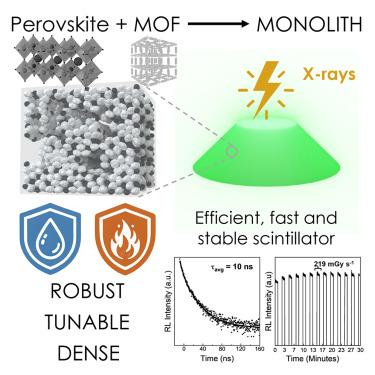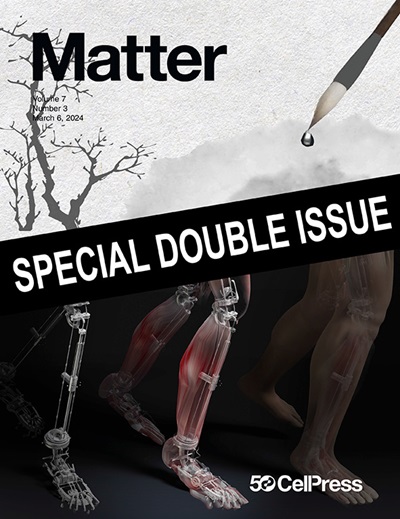Better together: Monolithic halide perovskite@metal-organic framework composites
IF 17.3
1区 材料科学
Q1 MATERIALS SCIENCE, MULTIDISCIPLINARY
引用次数: 0
Abstract
The instability and limited scalability of halide perovskites hinder their long-term viability in applications as X-ray detectors. Here, we introduce a sol-gel ship-in-bottle approach to produce a monolithic perovskite@metal-organic framework (MOF) composite, combining the properties of the individual building blocks and enhancing density, robustness, and stability. By tuning seed particles below 100 nm, we achieve highly crystalline, dense composites with up to 40% perovskite loading. Structural and optical characterization unveils perovskite nanocrystals forming within MOF mesopores, maximizing stability and preventing degradation, maintaining over 90% photoluminescence and structural integrity after weeks of exposure to humidity, heat, and solvents. Proposed as an innovative class of scintillator, these monolithic perovskite@MOFs attenuate X-rays efficiently and exhibit outstanding stability under high radiation doses equivalent to 110,000 typical chest X-rays, with a radioluminescence lifetime of 10 ns, outperforming commercial scintillators. This approach offers vast potential for developing high-performance, cost-effective, and stable devices for radiation detection and other optoelectronic applications.


更好地结合在一起:单片卤化物过氧化物@金属有机框架复合材料
卤化物过氧化物的不稳定性和有限的可扩展性阻碍了其在 X 射线探测器应用中的长期可行性。在这里,我们介绍了一种溶胶-凝胶瓶中船方法,用于生产整体包光体@金属有机框架(MOF)复合材料,结合了单个构件的特性,提高了密度、坚固性和稳定性。通过调节低于 100 纳米的种子颗粒,我们实现了高结晶、高致密的复合材料,其包晶石含量高达 40%。结构和光学表征揭示了在 MOF 介孔中形成的包光体纳米晶体,最大限度地提高了稳定性并防止了降解,在暴露于湿度、热量和溶剂数周后,仍能保持 90% 以上的光致发光和结构完整性。作为一种创新型闪烁体,这些单片包晶@MOFs 能有效衰减 X 射线,并在相当于 11 万次典型胸部 X 射线的高辐射剂量下表现出卓越的稳定性,其放射发光寿命为 10 ns,优于商用闪烁体。这种方法为开发用于辐射检测和其他光电应用的高性能、高性价比和稳定的器件提供了巨大的潜力。
本文章由计算机程序翻译,如有差异,请以英文原文为准。
求助全文
约1分钟内获得全文
求助全文
来源期刊

Matter
MATERIALS SCIENCE, MULTIDISCIPLINARY-
CiteScore
26.30
自引率
2.60%
发文量
367
期刊介绍:
Matter, a monthly journal affiliated with Cell, spans the broad field of materials science from nano to macro levels,covering fundamentals to applications. Embracing groundbreaking technologies,it includes full-length research articles,reviews, perspectives,previews, opinions, personnel stories, and general editorial content.
Matter aims to be the primary resource for researchers in academia and industry, inspiring the next generation of materials scientists.
 求助内容:
求助内容: 应助结果提醒方式:
应助结果提醒方式:


